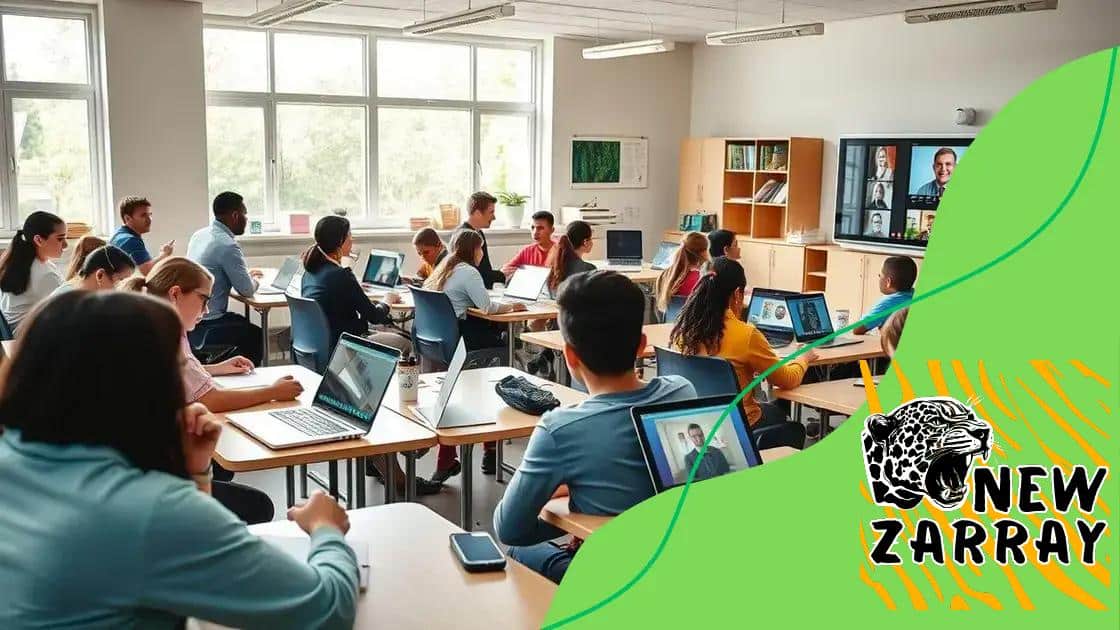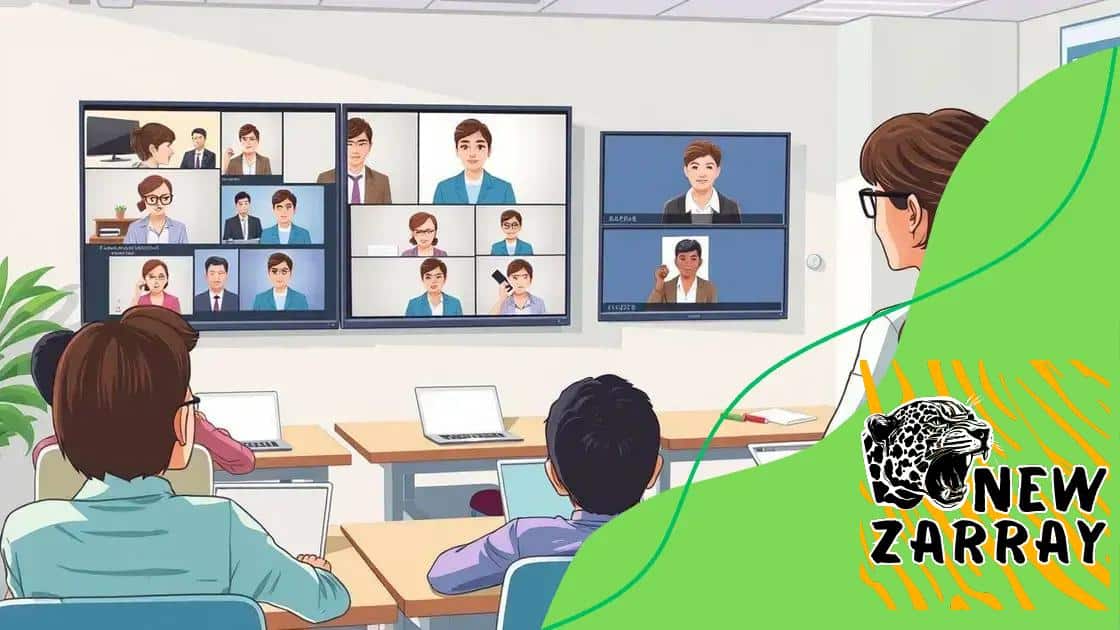Hybrid learning methods for academic success post-pandemic

Hybrid learning methods for academic success post-pandemic combine in-person and online education, providing flexibility, enhanced engagement, and personalized learning experiences that accommodate diverse student needs.
Hybrid learning methods for academic success post-pandemic are reshaping how students engage with their education. Have you ever considered how these approaches might impact your learning experience and outcomes? Let’s delve into the details.
Understanding hybrid learning methods
Understanding hybrid learning methods is essential for adapting to modern education. These methods combine in-person and online learning, providing flexibility for students and teachers. This approach allows educators to meet diverse learning needs more effectively.
What are hybrid learning methods?
Hybrid learning methods integrate both face-to-face and virtual classroom settings. This means that students may attend classes physically a few days a week while completing the rest of their coursework online. This flexibility promotes greater access to education.
Benefits of hybrid learning
- Flexibility: Students can learn at their own pace.
- Accessibility: Offers opportunities for those unable to attend in person.
- Personalized learning: Teachers can tailor lessons to meet individual student needs.
As schools continue to explore these methods, many educators find that hybrid learning promotes student engagement and better academic performance. Students benefit from having resources available online, allowing for deeper learning moments outside the traditional classroom.
Teachers also gain from this method by utilizing various tools and technologies. Virtual classrooms can incorporate interactive activities, which enhance the learning experience. This combination enriches classroom dynamics, encouraging collaboration among peers.
Ultimately, as we dive deeper into hybrid learning methods, it’s clear they address the challenges posed by the pandemic while preparing students for future educational landscapes. By adapting to this blend of learning environments, we can foster a more resilient educational system.
Benefits of hybrid learning for students
The benefits of hybrid learning for students are numerous and impactful. One of the most significant advantages is flexibility. Students can learn at their own pace, allowing them to balance their studies with other commitments.
Personalized Learning Experience
With hybrid learning, education becomes tailored to individual needs. Students can choose when and how to engage with course materials, enhancing their understanding of subjects. This individualized approach often leads to better academic performance.
Accessibility and Convenience
- Greater access: Students from various backgrounds can attend classes without geographical barriers.
- Convenient schedules: Online components allow learning at times that suit each student.
- Resource availability: Students have access to a wealth of online materials that support their learning.
An additional benefit is the development of essential skills. Students engage with different technologies, which helps them become proficient in digital tools. These skills are crucial in today’s job market and prepare them for future careers.
Moreover, hybrid learning fosters collaboration. By interacting with peers in both physical and virtual spaces, students learn to communicate effectively across various platforms. They gain valuable teamwork experience, essential in every professional environment.
Overall, the benefits of hybrid learning significantly enhance the educational experience, making it more efficient and enjoyable for students. This innovative approach supports diverse learning styles and paves the way for a more inclusive educational landscape.
Challenges to consider in hybrid learning

While there are many advantages to hybrid learning, several challenges to consider in hybrid learning can impact its effectiveness. For instance, not all students may have equal access to the necessary technology. This disparity can lead to unequal learning experiences and outcomes.
Ensuring Effective Communication
Communication can be more complex when combining in-person and online learning. Teachers must find ways to engage both sets of students simultaneously. This requires planning and effective use of tools to maintain connection and interaction.
Technical Issues
- Internet reliability: Some students may face challenges due to poor internet connections at home.
- Technology proficiency: Both students and teachers need to be comfortable using online platforms and tools.
- Software compatibility: Different devices may not support the same software, complicating access to learning materials.
Another challenge involves maintaining student motivation. In a hybrid format, some students might feel detached from their peers. This lack of connection can hinder participation and overall engagement.
Moreover, assessment in hybrid learning can pose difficulties. Teachers must develop fair methods to evaluate students enrolled in different formats. This means creating assessments that are accessible to all and reflect the learning objectives clearly.
With these challenges in mind, addressing them proactively is essential to ensure that hybrid learning succeeds. By acknowledging potential hurdles, educators can implement strategies to foster a more inclusive and productive learning environment.
Key technologies for successful hybrid education
To ensure the effectiveness of hybrid education, several key technologies for successful hybrid education play a vital role. These tools help create engaging, interactive, and accessible learning experiences for students.
Learning Management Systems (LMS)
An effective Learning Management System is crucial for organizing course materials, assignments, and assessments. LMS platforms like Moodle or Canvas allow teachers to share resources and track student progress seamlessly.
Video Conferencing Tools
Video conferencing tools, such as Zoom or Microsoft Teams, facilitate real-time interaction between teachers and students. These platforms enable live discussions and collaboration, making remote learning more engaging.
Interactive Technologies
- Digital whiteboards: Tools like Jamboard help foster collaboration during lessons.
- Polling software: Tools like Mentimeter allow teachers to gauge understanding and gather feedback quickly.
- Virtual simulations: Resources that help demonstrate concepts in engaging ways can enhance learning.
Additionally, communication apps enhance connectivity between students and instructors, ensuring that everyone stays informed about course updates and requirements. Tools like Slack or Discord can serve as effective communication platforms, allowing for discussions and announcements.
Smart devices, such as tablets and laptops, are also critical in a hybrid learning environment. They enable students to access online resources anywhere, anytime. This flexibility supports diversified learning and caters to different student needs.
The integration of key technologies into hybrid education provides an opportunity for a more dynamic and effective learning experience. Adopting these tools can help educators meet challenges and enrich students’ educational journeys.
Success stories of hybrid learning implementation
There are several inspiring success stories of hybrid learning implementation that highlight its effectiveness in enhancing educational outcomes. Many schools have adopted this approach, transforming the way students learn and interact.
Case Study: Riverside High School
Riverside High School implemented a hybrid model that combined in-person classes with online labs. This approach allowed students to engage more deeply with the subject matter. Teachers reported improved student engagement and higher test scores. The flexibility offered by the hybrid model helped students better manage their time and study habits.
Case Study: Oakwood Community College
At Oakwood Community College, the hybrid format increased enrollment numbers significantly. By offering both online and on-campus courses, the college attracted a diverse range of students. Many appreciated the option to attend classes remotely while still having access to campus resources. This flexibility made education more accessible and inclusive.
Key Elements of Success
- Strong communication: Regular check-ins between teachers and students helped maintain engagement.
- Support resources: Access to tutoring and counseling online made a difference.
- Technology training: Training sessions for both teachers and students ensured everyone was comfortable with digital tools.
These stories demonstrate the positive impact of hybrid learning when well-implemented. Schools that prioritize integration, accessibility, and student well-being see remarkable improvements in academic performance and satisfaction.
As more institutions embrace this innovative approach, it’s fascinating to witness how hybrid learning continues to evolve, adapting to meet the needs of students in a rapidly changing educational landscape.
FAQ – Frequently Asked Questions about Hybrid Learning
What are the main benefits of hybrid learning?
Hybrid learning offers flexibility, better engagement, and the ability to accommodate diverse learning styles.
How can technology enhance hybrid education?
Technology supports communication, access to resources, and interactive learning experiences for both students and teachers.
What challenges might schools face with hybrid learning?
Challenges include ensuring equal access to technology, maintaining student motivation, and managing effective communication.
Can hybrid learning work for all subjects?
Yes, hybrid learning can be adapted to various subjects, but it may require specific strategies and resources for different disciplines.





